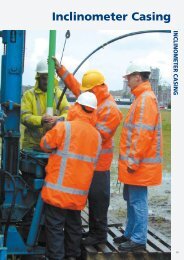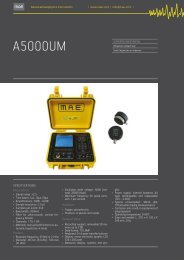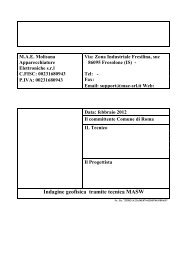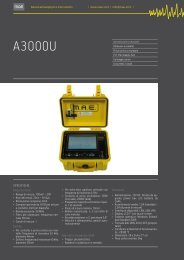Untitled
Untitled
Untitled
You also want an ePaper? Increase the reach of your titles
YUMPU automatically turns print PDFs into web optimized ePapers that Google loves.
› Seismic Monitoring<br />
40<br />
SETA SYSTEM<br />
SUPPORTED INVESTIGATION<br />
Seismological studies<br />
Territorial seismic monitoring<br />
SPECIFICATIONS<br />
The seismic acquisition system called SETA<br />
SYSTEM has been developed by MAE in jointventure<br />
with partners of high profile, such<br />
as: the National Institute of Oceanography<br />
and Experimental Geo-physics, OGS, located<br />
in Trieste, and the National Institute of Geophysics<br />
Georgiano, IGEM, located in Tbilisi.<br />
The system allows to create architectures<br />
for seismic networks in digital telemetry<br />
with 24-bit resolution, using the two basic<br />
units of the system or the RX-16 receiver,<br />
with 16 inlets for as many transmitting<br />
units TX-3, properly located on the territory<br />
that must be monitored. The S.E.T.A system<br />
has been developed with the purpose<br />
to create a vast territorial network of seismic<br />
monitoring stations, completely independent<br />
in terms of energy and radio communications,<br />
able to monitor the seismic/<br />
micro-seismic activity of the territorial area<br />
where it is located, 24 hours a day. The remote<br />
units are installed in suitable rural containers,<br />
which characteristics are developed<br />
based on the specifications of each system.<br />
These are usually fed by battery packs with<br />
high autonomy, re-charged through solar<br />
panels or other solutions. The digital transmitting<br />
unit TX- 3 AD is equipped with 3 inlet<br />
channels with 24-bit resolution, and allows<br />
to use velocimeters with 1/2 Hz frequencies<br />
or mono and three-axial accelerometers, in<br />
addition to geophones of different frequency.<br />
It is stored inside a sturdy steel container,<br />
it codes and transmits via radio the signals<br />
coming from the seismic sensors to<br />
the Data Collection Station, with which it is<br />
in constant connection, where one or more<br />
RX-16 units have been installed, which receive<br />
and decode the data acquired locally<br />
by the remote units. The data transmitted<br />
by the RX-16 in real time can be then treated<br />
with different types of analysis software<br />
and stored through proper procedures, thus<br />
allowing the creation of an archive of seismic<br />
events of the geographic region object of the<br />
study. The data collected allows to know and<br />
constantly monitor the seismic activity in<br />
the monitored region. The system has been<br />
conceived to work with automatic recording<br />
and signalling modes of the events that occur<br />
on all the remote stations connected to<br />
the system. The data coming from the remote<br />
stations of the network can be viewed<br />
on the terminals of the Data Collection Centre<br />
24 hours a day.<br />
mae-srl.it/go/setasystem









